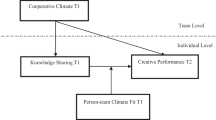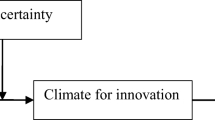Abstract
In today’s creative economy, individuals generally have not been regarded as reservoirs of creativity who yield sustainable growth in hypercompetitive markets. Individuals rely on IT support to reduce clerical loads and enhance the effectiveness and efficiency of their work as well. When they work in teams, they also require self-confidence and the need for cognition to promote their individual creativity. Data were derived from the members of a large system integration company in South Korea (N = 256, 50 teams). As the study considered variables at both the team and individual levels, we adopted a multilevel analysis approach. We found that individual self-confidence, which indicates the degree of perceived possibility of success at a task, and the need for cognition, the intrinsic motivation to engage in and enjoy thinking, affected individual creativity significantly. Further, the degree of IT support, the team-level variable, had a significant effect on individual creativity. The degree of IT support did not have a significant effect on the relationship between self-confidence and individual creativity, but did have a moderating effect that weakened the relationship between the need for cognition and individual creativity. These findings have implications for theories of members’ creativity in organizations.



Similar content being viewed by others
References
Amabile, T. M. (1983). The social psychology of creativity: a componential conceptualization. Journal of Personality and Social Psychology, 45(2), 357.
Amabile, T. M. (1996). Creativity in context: Update to" the social psychology of creativity.". Westview press
Arch, E. C. (1992). Sex differences in the effect of self-efficacy on willingness to participate in a performance situation. Psychological Reports, 70(1), 3–9.
Bakos, J. Y., & Treacy, M. E. (1986). Information technology and corporate strategy: a research perspective. MIS Quarterly, 10(2), 107–119.
Bandura, A. (1992). Exercise of personal agency through the self-efficacy mechanism. In This chapter includes revised and expanded material presented as an invited address at the annual meeting of the British Psychological Society, St. Andrews, Scotland, Apr 1989.. Hemisphere Publishing Corp
Boyd, N. G., & Vozikis, G. S. (1994). The influence of self-efficacy on the development of entrepreneurial intentions and actions. Entrepreneurship: Theory and Practice, 18(4), 63–77.
Cacioppo, J. T., & Petty, R. E. (1982). The need for cognition. Journal of Personality and Social Psychology, 42(1), 116.
Cacioppo, J. T., Petty, R. E., & Kao, C. F. (1984). The efficient assessment of need for cognition. Journal of Personality Assessment, 48(3), 306–307.
Cacioppo, J. T., Petty, R. E., Feinstein, J. A., & Jarvis, W. B. G. (1996). Dispositional differences in cognitive motivation: the life and times of individuals varying in need for cognition. Psychological Bulletin, 119(2), 197.
Davis, G. A. (1986). Creativity is forever (2nd ed.). Dubuque, IA: Kendall Hunt Publishing Company
Doll, W. J., & Torkzadeh, G. (1988). The measurement of end-user computing satisfaction. MIS Quarterly, 12(2), 259–274.
Ein-Dor, P., & Segev, E. (1982). Organizational context and MIS structure: some empirical evidence. MIS Quarterly, 6(3), 55–68.
Estrada, C. A., Isen, A. M., & Young, M. J. (1994). Positive affect improves creative problem solving and influences reported source of practice satisfaction in physicians. Motivation and Emotion, 18(4), 285–299.
Gallupe, R. B., Bastianutti, L. M., & Cooper, W. H. (1991). Unblocking brainstorms. Journal of Applied Psychology, 76(1), 137.
Glick, W. H. (1985). Conceptualizing and measuring organizational and psychological climate: pitfalls in multilevel research. Academy of Management Review, 10(3), 601–616.
Henning, B., & Vorderer, P. (2001). Psychological escapism: predicting the amount of television viewing by need for cognition. Journal of Communication, 51(1), 100–120.
Hirt, E. R., Melton, R. J., McDonald, H. E., & Harackiewicz, J. M. (1996). Processing goals, task interest, and the mood–performance relationship: a mediational analysis. Journal of Personality and Social Psychology, 71(2), 245.
Hofmann, D. A. (1997). An overview of the logic and rationale of hierarchical linear models. Journal of Management, 23(6), 723–744.
Hollenbeck, G. P., & Hall, D. T. (2004). Self-confidence and leader performance. Organizational Dynamics, 33(3), 254–269.
James, L. R., Demaree, R. G., & Wolf, G. (1984). Estimating within-group interrater reliability with and without response bias. Journal of Applied Psychology, 69(1), 85–98.
Kerlinger, F. N., & Lee, H. B. (2000). Foundations of behavioral research (4th ed.). Fort Worth, TX: Harcourt College Publishers.
Khatena, J., & Torrance, E. P. (1976). Khatena-Torrance creative perception inventory. Stoelting Company.
Kickul, J., Wilson, F., Marlino, D., & Barbosa, S. D. (2008). Are misalignments of perceptions and self-efficacy causing gender gaps in entrepreneurial intentions among our nation’s teens? Journal of Small Business and Enterprise Development, 15(2), 321–335.
Klein, K. J., & Kozlowski, S. W. (2000). Multilevel theory, research, and methods in organizations: Foundations, extensions, and new directions. Jossey-Bass.
Klein, K. J., Dansereau, F., & Hall, R. J. (1994). Levels issues in theory development, data collection, and analysis. Academy of Management Review, 19(2), 195–229.
Kolb, J. A. (1999). The effect of gender role, attitude toward leadership, and self-confidence on leader emergence: implications for leadership development. Human Resource Development Quarterly, 10(4), 305–320.
Kozlowski, S. W., & Hattrup, K. (1992). A disagreement about within-group agreement: disentangling issues of consistency versus consensus. Journal of Applied Psychology, 77(2), 161–167.
Kwang, N. A., & Rodrigues, D. (2002). A big-five personality profile of the adaptor and innovator. The Journal of Creative Behavior, 36(4), 254–268.
Martindale, C. (1989). Handbook of creativity. In Personality, situation, and creativity (pp. 211–232). US: Springer.
McClelland, D. C. (1987). Human motivation. CUP Archive.
Mumford, M. D., & Gustafson, S. B. (1988). Creativity syndrome: integration, application, and innovation. Psychological Bulletin, 103(1), 27–43.
Nonaka, I. (2008). The knowledge-creating company. Harvard Business Review Press.
O’Hara, L. A., & Sternberg, R. J. (2001). It doesn’t hurt to ask: effects of instructions to be creative, practical, or analytical on essay-writing performance and their interaction with students’ thinking styles. Creativity Research Journal, 13(2), 197–210.
Raudenbush, S. W. (1989). A response to Longford and Plewis. Multilevel Modelling Newsletter, 1(3), 8–10.
Raudenbush, S. W. (2004). HLM 6: Hierarchical linear and nonlinear modeling. Scientific Software International.
Raudenbush, S. W., & Bryk, A. S. (2002). Hierarchical linear models: Applications and data analysis methods (Vol. 1). Sage
Redmond, M. R., Mumford, M. D., & Teach, R. (1993). Putting creativity to work: effects of leader behavior on subordinate creativity. Organizational Behavior and Human Decision Processes, 55(1), 120–151.
Robinson, W. (1950). Ecological correlations and the behavior of American individual. American Sociological Review, 15(3), 351–357.
Rodan, S., & Galunic, C. (2004). More than network structure: how knowledge heterogeneity influences managerial performance and innovativeness. Strategic Management Journal, 25(6), 541–562.
Rosenberg, M., & Kaplan, H. B. (Eds.) (1982). Social psychology and the self-concept. Arlington Heights, IL: Harlan Davidson.
Runco, M. A., & Chand, I. (1995). Cognition and creativity. Educational Psychology Review, 7(3), 243–267.
Schunk, D. H. (1991). Self-efficacy and academic motivation. Educational Psychologist, 26(3–4), 207–231.
Shalley, C. E., & Gilson, L. L. (2004). What leaders need to know: a review of social and contextual factors that can foster or hinder creativity. The Leadership Quarterly, 15(1), 33–53.
Shalley, C. E., Zhou, J., & Oldham, G. R. (2004). The effects of personal and contextual characteristics on creativity: where should we go from here? Journal of Management, 30(6), 933–958.
Shneiderman, B. (2009). Engineering the User Interface. In Creativity support tools: A grand challenge for HCI researchers (pp. 1–9). London: Springer.
Sternberg, R. J. (1988). The nature of creativity: Contemporary psychological perspectives. CUP Archive.
Sternberg, R. J., & Lubart, T. I. (1991). An investment theory of creativity and its development. Human Development, 34(1), 1–31.
Terry, M., Mynatt, E. D., Nakakoji, K., & Yamamoto, Y. (2004). Variation in element and action: supporting simultaneous development of alternative solutions. In Proceedings of the SIGCHI conference on Human factors in computing systems (pp. 711–718). ACM
Tierney, P., & Farmer, S. M. (2002). Creative self-efficacy: its potential antecedents and relationship to creative performance. Academy of Management Journal, 45(6), 1137–1148.
Tuten, T. L., & Bosnjak, M. (2001). Understanding differences in web usage: the role of need for cognition and the five factor model of personality. Social Behavior and Personality: An International Journal, 29(4), 391–398.
Vollmer, F. (1986). Why do men have higher expectancy than women? Sex Roles, 14(7–8), 351–362.
Wierenga, B., & Bruggen, G. H. (1998). Drivers of Success for Marketing Management Support Systems: Towards a Theory of Marketing Decision Support. Faculteit Bedrijfskunde/Rotterdam School of Management: Erasmus Universiteit Rotterdam.
Wilson, F., Kickul, J., & Marlino, D. (2007). Gender, entrepreneurial self-efficacy, and entrepreneurial career intentions: implications for entrepreneurship Education1. Entrepreneurship theory and practice, 31(3), 387–406.
Woodman, R. W., Sawyer, J. E., & Griffin, R. W. (1993). Toward a theory of organizational creativity. Academy of Management Review, 18(2), 293–321.
Zhou, J., & George, J. M. (2001). When job dissatisfaction leads to creativity: encouraging the expression of voice. Academy of Management Journal, 44(4), 682–696.
Zhou, J., & Shalley, C. E. (2003). Research on employee creativity: a critical review and directions for future research. Research in Personnel and Human Resources Management, 22, 165–218.
Acknowledgments
This research was supported by National Research Foundation of Korea Grant funded by the Korean Government (NRF-2014S1A3A2038108).
Author information
Authors and Affiliations
Corresponding author
Ethics declarations
Conflict of Interest
Min Hee Hahn declares that he has no conflict of interest. Kun Chang Lee declares that he has no conflict of interest.
Rights and permissions
About this article
Cite this article
Hahn, M.H., Lee, K.C. Exploring the Role of Self-Confidence, Need-for-Cognition, and the Degree of IT Support on Individual Creativity: Multilevel Analysis Approach. Curr Psychol 36, 565–576 (2017). https://doi.org/10.1007/s12144-016-9445-z
Published:
Issue Date:
DOI: https://doi.org/10.1007/s12144-016-9445-z




